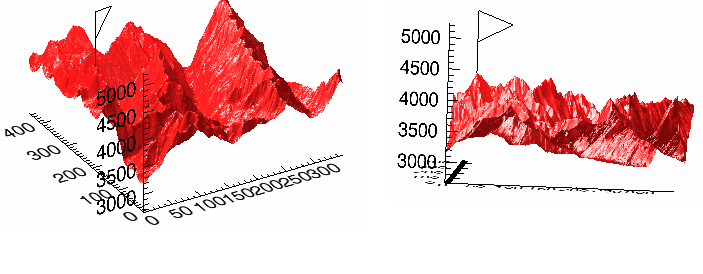ARRAY_INDICES
The ARRAY_INDICES function converts one-dimensional subscripts of an array into corresponding multi-dimensional subscripts.
This routine is written in the IDL language. Its source code can be found in the file array_indices.pro in the lib subdirectory of the IDL distribution.
Examples
Example 1
This example finds the location of the maximum value of a random 10 by 10 array:
seed = 111
array = RANDOMU(seed, 10, 10, /RAN1)
mx = MAX(array, location)
ind = ARRAY_INDICES(array, location)
PRINT, ind, array[ind[0],ind[1]], $
FORMAT = '(%"Value at [%d, %d] is %f")'
IDL prints:
Value at [3, 6] is 0.973381
For more illustrations of the ARRAY_INDICES function, see Additional Examples.
Syntax
Result = ARRAY_INDICES(Array, Index [, /DIMENSIONS] )
Return Value
If Index is a scalar, returns a vector containing m dimensional subscripts, where m is the number of dimensions of Array.
If Index is a vector containing n elements, returns an (m x n) array, with each row containing the multi-dimensional subscripts corresponding to that index.
Arguments
Array
An array of any type, whose dimensions should be used in converting the subscripts. If DIMENSIONS is set then Array should be a vector containing the dimensions.
Index
A scalar or vector containing the one-dimensional subscripts to be converted.
Keywords
DIMENSIONS
If this keyword is set, then Array is assumed to be a vector containing the dimensions.
Tip: This keyword is useful when you do not have the actual Array, and want to avoid allocating the array just to find the indices.
Additional Examples
Example 2
This example is the same as the previous example, but uses the /DIMENSIONS keyword.
seed = 111
array = RANDOMU(seed, 10, 10)
mx = MAX(array, location)
dims = SIZE(array, /DIMENSIONS)
ind = ARRAY_INDICES(dims, location, /DIMENSIONS)
print, ind, array[ind[0],ind[1]], $
format = '(%"Value at [%d, %d] is %f")'
IDL prints:
Value at [3, 6] is 0.973381
Example 3
This example routine locates the highest point in the example Maroon Bells data set and places a flag at that point.
Enter the following code in the IDL editor:
PRO ExARRAY_INDICES
; Import Maroon Bells data.
file = FILEPATH('surface.dat', $
SUBDIRECTORY = ['examples', 'data'])
data = READ_BINARY(file, DATA_DIMS=[350, 450], $
DATA_TYPE=2, ENDIAN='little')
; Display data.
ISURFACE, data
; Calculate the value and one-dimensional
; array location of the highest point.
maxValue = MAX(data, maxPoint)
; Using ARRAY_INDICES to convert the one-
; dimensional array location to a two-
; dimensional aray location.
maxLocation = ARRAY_INDICES(data, maxPoint)
; Print the results.
PRINT, 'Highest Point Location: ', maxLocation
PRINT, 'Highest Point Value: ', maxValue
; Create flag for the highest point.
x = maxLocation[0]
y = maxLocation[1]
z = maxValue
xFlag = [x, x, x + 50., x]
yFlag = [y, y, y + 50., y]
zFlag = [z, z + 1000., z + 750., z + 500.]
; Display flag at the highest point.
IPLOT, xFlag, yFlag, zFlag, /OVERPLOT
END
Save the code as ExARRAY_INDICES.pro, compile it and run it. The following figure displays the output of this example:

For a better view of the flag, use the Rotate tool to rotate the surface.
Version History
|
6.0 |
Introduced |